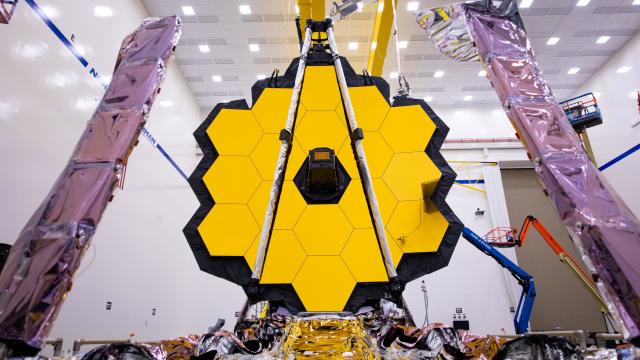NASA hopes to launch the much-anticipated James Webb Space Telescope from French Guiana on October 31, 2021, the agency announced today. Ongoing technical challenges and the covid-19 pandemic were cited as reasons for the latest delay to the project.
A launch on Halloween seems only appropriate for this beleaguered project, which has been marred by a steady stream of cost overruns and scheduling delays since its inception. The powerful telescope was originally supposed to go to space in 2007.
The new date ” October 31, 2021 ” represents a seven-month delay from the most recent launch target of March 2021 atop an Ariane 5 rocket. Before that, it was supposed to go up in May 2020. And so on in that fashion. Sadly, it’s hard to get excited by the new launch date. It’s become a kind of “we’ll believe it when we see it” sort of thing.
James Webb is the successor to the Hubble Space Telescope, which is now 30 years old. The project is currently in the integration and testing phase of development, the final phase before it gets transported to French Guiana. Once in space, some million miles away from Earth, Webb will use its infrared telescope to observe some of the oldest galaxies in the universe, study star-forming nebulae, and even scan the atmospheres of distant exoplanets. There’s no question this observatory is going to be amazing ” it just needs to get done.
At a NASA press conference earlier today, Gregory Robinson, JWST program director, said the decision to move the launch from March 2021 to October 2021 had to do with lingering development challenges and hardships imposed by the covid-19 pandemic. NASA, he said, was planning to re-evaluate the project’s schedule margins prior to covid-19, but the pandemic forced the issue, resulting in yet another delay.
Stephen Jurczyk, NASA associate administrator, said the primary challenge of covid-19 was the “impact of people not being at work and the reduced number of people available for shifts.” Social distancing and other on-site safety provisions were other factors negatively influencing the pace of development and testing of the telescope, he said.
Despite these hardships, teams at Northrop Grumman, the space agency’s principal contractor for the project, continue to work “tirelessly” and in an “intense environment,” said Jurczyk. “Team safety is our highest priority,” he added.
When asked to account for the seven-month delay, Robinson said three months had to do with covid-19 and two months had to do with existing technical issues, such as pending vibration testing, a review of the telescope’s new sunshield, risk-reduction measures, among other outstanding tasks. The remaining two months were added as a buffer, said Robinson.
According to a NASA press release, there will be no more cost overruns as a result of this particular delay, as “Webb will use existing program funding to stay within its $US8.8 ($13) billion development cost cap.”
On a positive note, the JWST development team recently completed a comprehensive systems test, in which critical software and electrical components were tested across the entire observatory. Over the next few months, the team will perform important vibration and acoustic tests to simulate the shaking that will occur during launch.
NASA and Northrop Grumman appear to be making progress, but they’re not past the finish line yet. It’s easy to be pessimistic, given the project’s history and now the spooky launch date, but this thing has to get to space eventually. Right?
